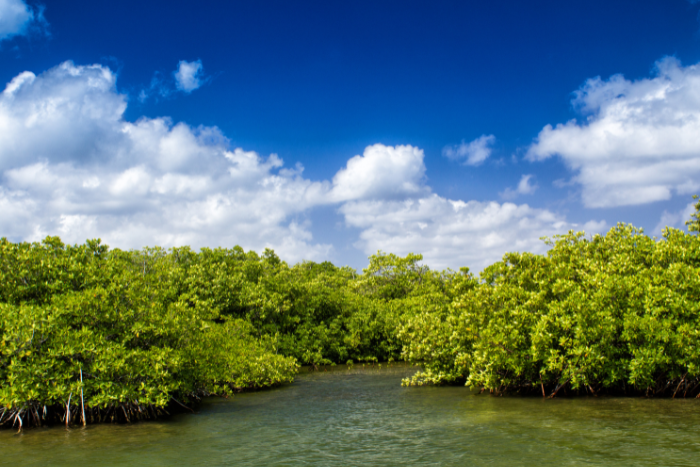Mangroves in regions such as southern India, southeastern China, Singapore and eastern Australia are particularly affected, finds the study
According to a new study published in IOP Publishing’s journal Environmental Research Letters, the annual rate of carbon emissions due to the degradation of carbon stocks in mangrove forests is predicted to rise by nearly 50,000% by the end of the century. The study said that mangroves in regions such as southern India, southeastern China, Singapore and eastern Australia are particularly affected.
In order to estimate the role of mangrove forests in the global carbon budget, the study focussed on the relationship between human population density and soil carbon stocks in urban mangrove forests.
The impact of urbanisation on mangroves
Mangrove forests store a large amount of carbon, particularly in their soils, however human development in these areas has led to the degradation of these carbon stocks.
“Mangroves located in urban areas are subject to overexploitation of ecosystem goods, poor air quality, and soil and water pollution. These can all directly or indirectly impact mangrove tree growth, soil structure, and microbial communities; due to low carbon inputs from trees (assume trees are not growing well) and degraded soil quality, the ability of soil to store carbon is likely to decrease. Therefore, mangrove soils are less likely to store carbon over time, even becoming a carbon source,” Shih-Chieh Chien, lead author of the paper, told CarbonCopy over an email.
According to Chien, when mangroves are replaced by agriculture and aquaculture, deforestation causes a large amount of carbon loss when trees are cut down and burnt, as well as when soils are removed (the carbon dioxide and methane typically stored in soils are released). Remaining mangroves near the lands of agriculture and aquaculture are also vulnerable to overexploitation of ecosystem goods and water pollution
The study said that over the past 20 years, a substantial number of mangrove forests have been replaced by agriculture, aquaculture and urban land management, leading global mangrove carbon stocks to decline by 158.4 million tonnes – releasing the same level of carbon emissions as flying the entire US population from New York to London.
The study mentioned that mangrove forests in urban areas are more vulnerable to environmental pollution of trace metals, microplastics and organic compounds.
How do these factors affect mangrove soil and contribute to higher carbon emissions?
“Metals, microplastics and organic compounds typically degrade soil structure and impair microbial and plant growth. All of these can relate to the ability of soil to store carbon. For example, microorganisms typically contribute to soil organic carbon. When soils are contaminated by metals and microplastics, microbial biomass is lower (lower amount of carbon in soils). Moreover, when dead microorganisms are consumed by other microbes and small animals, carbon is released from soils (carbon loss),” answered Chien.
“When mangrove trees do not grow well because of environmental pollution”, Chien added, “they typically contribute less carbon to soils. Lower amount of carbon inputs from plants is less likely to compensate for higher soil carbon emission.”
Temperature, precipitation and population density
The study also looked into the relationships between temperature/precipitation/population density and mangrove soil carbon, respectively. Both temperature and precipitation showed a positive correlation to soil carbon, while human population density showed a negative correlation with mangrove soil carbon. This means that when temperature and precipitation increase, soil carbon increases and when human density increases, soil carbon decreases.
However, researchers said that they found that the negative correlation between population density and mangrove soil carbon is reduced when other factors are included. This means population density is actually a weaker factor in relating to soil carbon compared to temperature or precipitation.
High vulnerability in global south
The research said that higher human population density is mainly located in southeastern China, southern India, Singapore, and southwestern Indonesia. Researchers said that in these regions, the intrinsic traits that differentiate mangrove ecosystems from each other may include climatic conditions, dominant tree species, topography (like upstream river and altitude), and the oceanic environments that connect the mangroves. All these factors can also shape soil properties and microbial communities in those mangrove ecosystems.
However, with high human population density, Chein believed that mangroves are facing similar traits. “This is because the way that human activities pollute natural environments can be uniform, regardless of geographical areas around the world. However, mangroves from different regions may respond differently to common threats caused by human impacts, depending on their initial conditions of ecosystem resilience and health.”
Need for conservation
Mangrove forests cover approximately 0.1% of the Earth’s land surface but play a vital role in providing wildlife habitats and regulating global climate stability. These mangroves store a large amount of carbon, particularly in their soils, and are essential to regulating carbon cycling on a global scale. Mangrove soils contain three to four times the mass of carbon typically found in boreal, temperate, or tropical forests.
According to researchers, mangrove forests are critical to the regulation of carbon sequestration, and it is important to protect them. However, the first step is to understand the impact of human populations and activities on mangrove forest carbon stocks.
About The Author
You may also like
22 July goes down as the world’s hottest day on record
Tropical forest biodiversity at high risk from climate change due to temperature change under canopies: Study
India’s June rainfall 11% below normal, fifth-lowest since 2020
With record breaking rain and heat, Uttarakhand reels under climate change impacts
Earth surpasses 1.5°C warming threshold for 12 months in a row


